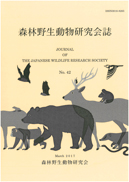Volume 46
Displaying 1-7 of 7 articles from this issue
- |<
- <
- 1
- >
- >|
Original article
-
2021 Volume 46 Pages 1-12
Published: March 31, 2021
Released on J-STAGE: July 12, 2025
Download PDF (2099K)
Short communication
-
2021 Volume 46 Pages 13-19
Published: March 31, 2021
Released on J-STAGE: July 12, 2025
Download PDF (1196K) -
2021 Volume 46 Pages 21-25
Published: March 31, 2021
Released on J-STAGE: July 12, 2025
Download PDF (551K) -
2021 Volume 46 Pages 27-32
Published: March 31, 2021
Released on J-STAGE: July 12, 2025
Download PDF (1002K)
Material
-
2021 Volume 46 Pages 33-40
Published: March 31, 2021
Released on J-STAGE: July 12, 2025
Download PDF (401K)
Book review
-
2021 Volume 46 Pages 41-42
Published: March 31, 2021
Released on J-STAGE: July 12, 2025
Download PDF (348K) -
2021 Volume 46 Pages 43-44
Published: March 31, 2021
Released on J-STAGE: July 12, 2025
Download PDF (340K)
- |<
- <
- 1
- >
- >|
